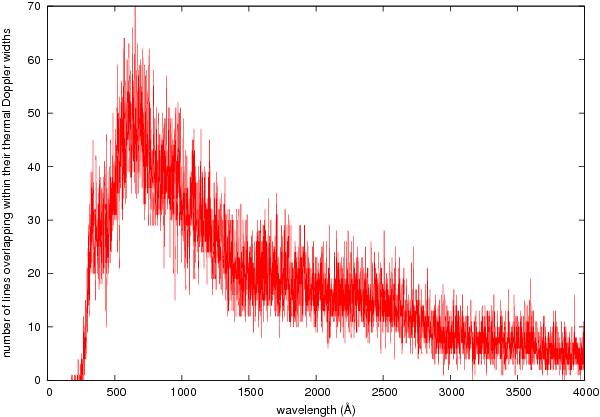Fig. 11

Number of lines overlapping within their thermal Doppler widths
 as a function of wavelength. (Only
lines from the lowest three ionization stages, excluding forbidden lines, were
considered for this plot. The overwhelming majority of these lines is from
iron-group elements. The thermal Doppler width was calculated for a representative
element of this element-group using a temperature typical for SN Ia, and is on the
order of 0.01 Å at a wavelength of 1000 Å.) The behavior that up to 70 lines from
different elements of the iron-group dominated SN Ia ejecta overlap per Doppler
width is the origin of a hidden form of deadlock of the lambda iteration used to
solve the multi-level non-LTE problem, and a straightforward lambda iteration will
fail to converge under such circumstances unless special measures are taken.
This lambda iteration deadlock is a general problem because it is solely
based on the fact that a large number of lines overlap within the thermal Doppler
widths of the lines, and this behavior cannot be influenced by choosing
extremely narrow frequency and radius grids, or by choosing a different procedure to
solve the radiative transfer (comoving frame or observer’s frame).
as a function of wavelength. (Only
lines from the lowest three ionization stages, excluding forbidden lines, were
considered for this plot. The overwhelming majority of these lines is from
iron-group elements. The thermal Doppler width was calculated for a representative
element of this element-group using a temperature typical for SN Ia, and is on the
order of 0.01 Å at a wavelength of 1000 Å.) The behavior that up to 70 lines from
different elements of the iron-group dominated SN Ia ejecta overlap per Doppler
width is the origin of a hidden form of deadlock of the lambda iteration used to
solve the multi-level non-LTE problem, and a straightforward lambda iteration will
fail to converge under such circumstances unless special measures are taken.
This lambda iteration deadlock is a general problem because it is solely
based on the fact that a large number of lines overlap within the thermal Doppler
widths of the lines, and this behavior cannot be influenced by choosing
extremely narrow frequency and radius grids, or by choosing a different procedure to
solve the radiative transfer (comoving frame or observer’s frame).
Current usage metrics show cumulative count of Article Views (full-text article views including HTML views, PDF and ePub downloads, according to the available data) and Abstracts Views on Vision4Press platform.
Data correspond to usage on the plateform after 2015. The current usage metrics is available 48-96 hours after online publication and is updated daily on week days.
Initial download of the metrics may take a while.


